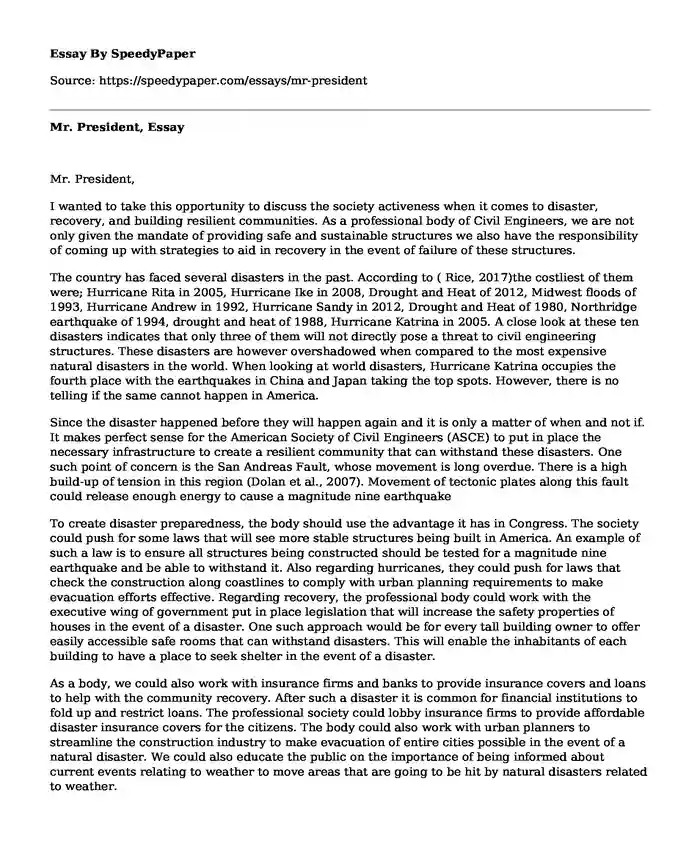Mr. President,
I wanted to take this opportunity to discuss the society activeness when it comes to disaster, recovery, and building resilient communities. As a professional body of Civil Engineers, we are not only given the mandate of providing safe and sustainable structures we also have the responsibility of coming up with strategies to aid in recovery in the event of failure of these structures.
The country has faced several disasters in the past. According to ( Rice, 2017)the costliest of them were; Hurricane Rita in 2005, Hurricane Ike in 2008, Drought and Heat of 2012, Midwest floods of 1993, Hurricane Andrew in 1992, Hurricane Sandy in 2012, Drought and Heat of 1980, Northridge earthquake of 1994, drought and heat of 1988, Hurricane Katrina in 2005. A close look at these ten disasters indicates that only three of them will not directly pose a threat to civil engineering structures. These disasters are however overshadowed when compared to the most expensive natural disasters in the world. When looking at world disasters, Hurricane Katrina occupies the fourth place with the earthquakes in China and Japan taking the top spots. However, there is no telling if the same cannot happen in America.
Since the disaster happened before they will happen again and it is only a matter of when and not if. It makes perfect sense for the American Society of Civil Engineers (ASCE) to put in place the necessary infrastructure to create a resilient community that can withstand these disasters. One such point of concern is the San Andreas Fault, whose movement is long overdue. There is a high build-up of tension in this region (Dolan et al., 2007). Movement of tectonic plates along this fault could release enough energy to cause a magnitude nine earthquake
To create disaster preparedness, the body should use the advantage it has in Congress. The society could push for some laws that will see more stable structures being built in America. An example of such a law is to ensure all structures being constructed should be tested for a magnitude nine earthquake and be able to withstand it. Also regarding hurricanes, they could push for laws that check the construction along coastlines to comply with urban planning requirements to make evacuation efforts effective. Regarding recovery, the professional body could work with the executive wing of government put in place legislation that will increase the safety properties of houses in the event of a disaster. One such approach would be for every tall building owner to offer easily accessible safe rooms that can withstand disasters. This will enable the inhabitants of each building to have a place to seek shelter in the event of a disaster.
As a body, we could also work with insurance firms and banks to provide insurance covers and loans to help with the community recovery. After such a disaster it is common for financial institutions to fold up and restrict loans. The professional society could lobby insurance firms to provide affordable disaster insurance covers for the citizens. The body could also work with urban planners to streamline the construction industry to make evacuation of entire cities possible in the event of a natural disaster. We could also educate the public on the importance of being informed about current events relating to weather to move areas that are going to be hit by natural disasters related to weather.
Please inform me of any questions you may have.
Best,
[Name]
Civil Engineering Major
American Society of Civil Engineers
References
Greentalk #2: 02/21/18 - Dr. Thalia Anagnos, Disaster And Recovery, Part 1 Of 2". Youtube, 2018, https://www.youtube.com/watch?v=vxE9WnVAXzs&list=PLP5K-8T3RpiJEp82BGSXg9h8QMaRl5AIF. Accessed 23 Feb 2018.
Dolan, J. F., Bowman, D. D., & Sammis, C. G. (2007). Long-range and long-term fault interactions in Southern California. Geology, 35(9), 855-858.
Rice, D. (2017). Harvey to be a costliest natural disaster in US history, estimated the cost of $190 billion. USA Today. https://www. USAToday. com/story/weather/2017/08/30/harveycostliest-natural-disaster-us-history-estimated-cost-160-billion/615708001/. Accessed, 1.
Cite this page
Mr. President,. (2022, Mar 28). Retrieved from https://speedypaper.net/essays/mr-president
Request Removal
If you are the original author of this essay and no longer wish to have it published on the SpeedyPaper website, please click below to request its removal:
- Essay Example on the Tendency for High Automation Rates
- Research Paper Essay Example
- Free Essay on the Benefits of Going to College
- Scholarship Cover Letter Sample in Our Free Essay
- Essay Sample: History of the Americas and the Civil Rights Movements
- Free Essay: America Before and After World War 1
- Free Essay on Wildfires: A Case Study of Los Angeles, California
Popular categories





